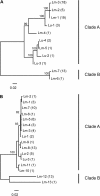Diversity and evolution of effector loci in natural populations of the plant pathogen Melampsora lini
- PMID: 19633228
- PMCID: PMC2767095
- DOI: 10.1093/molbev/msp166
Diversity and evolution of effector loci in natural populations of the plant pathogen Melampsora lini
Abstract
Genetic variation for pathogen infectivity is an important driver of disease incidence and prevalence in both natural and managed systems. Here, we use the interaction between the rust pathogen, Melampsora lini, and two host plants, Linum marginale and Linum usitatissimum, to examine how host-pathogen interactions influence the maintenance of polymorphism in genes underlying pathogen virulence. Extensive sequence variation at two effector loci (AvrP123, AvrP4) was found in M. lini isolates collected from across the native range of L. marginale in Australia, as well as in isolates collected from a second host, the cultivated species L. usitatissimum. A highly significant excess of nonsynonymous compared with synonymous polymorphism was found at both loci, suggesting that diversifying selection is important for the maintenance of the observed sequence diversity. Agrobacterium-mediated transient transformation assays were used to demonstrate that variants of both the AvrP123 and AvrP4 genes are differentially recognized by resistance genes in L. marginale. We further characterized patterns of nucleotide variation at AvrP123 and AvrP4 in 10 local populations of M. lini infecting the wild host L. marginale. Populations were significantly differentiated with respect to allelic representation at the Avr loci, suggesting the possibility of local selection maintaining distinct genetic structures between pathogen populations, whereas limited diversity may be explained via selective sweeps and demographic bottlenecks. Together, these results imply that interacting selective and nonselective factors, acting across a broad range of scales, are important for the generation and maintenance of adaptively significant variation in populations of M. lini.
Figures





References
-
- Alfano JR, Collmer A. Type III secretion system effector proteins: double agents in bacterial disease and plant defense. Annu Rev Phytopath. 2004;42:385–414. - PubMed
-
- Anderson RM, May RM. Coevolution of hosts and parasites. Parasitology. 1982;85:411–426. - PubMed
-
- Antonovics J, Thrall PH. Cost of resistance and the maintenance of genetic polymorphism in host-pathogen systems. Proc R Soc Lond B. 1994;257:105–110.
-
- Ayliffe MA, Dodds PN, Lawrence GJ. Characterisation of a β-tubulin gene from Melampsora lini and comparison of fungal β-tubulin genes. Mycol Res. 2001;105:818–826.
Publication types
MeSH terms
Substances
Grants and funding
LinkOut - more resources
Full Text Sources

